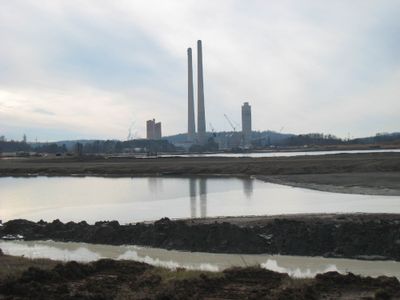Coal ash waste is the dirty secret of power plants
Nation’s dumps laden with toxic elements

WASHINGTON – The coal ash spill in Tennessee last month is putting a spotlight on whether the ash from 450 other power plants around the country could be contaminating the nation’s drinking water supplies.
Some coal ash is recycled into products such as cement or placed in secure landfills, but much of it ends up in gravel pits, abandoned mines and unlined landfills – or in ponds like the one that burst in Kingston, Tenn., on Dec. 22. In the Tennessee incident, 5.4 million cubic yards of sludge laced with toxic materials poured over 300 acres – making it one of the nation’s worst environmental spills.
The nation’s coal ash dumps contain millions of pounds of toxic metals such as arsenic, lead, cadmium, mercury and chromium, which can cause cancer or damage the nervous system and lungs and other organs if people ingest them. But it’s not entirely clear how much ash is stored around the country or where. The Environmental Protection Agency doesn’t track the number or have a breakdown for the states, said spokeswoman Tisha Petteway.
According to the American Coal Ash Association’s latest survey, in 2007, coal-fired plants generated 131 million tons of coal ash.
An Associated Press analysis of the most recent Energy Department data found that 156 coal-fired power plants in 32 states store millions of tons of coal ash in surface ponds similar to one that ruptured last month in Tennessee. Records indicate that states storing the most coal ash in ponds are Indiana, Ohio, Kentucky, Georgia and Alabama.
The man-made surface ponds hold a mixture of the noncombustible ingredients of coal and the ash trapped by equipment designed to reduce air pollution from the power plants. Over the years, the volume of waste has grown as demand for electricity increased and the federal government clamped down on emissions from power plants.
The EPA in 2000 decided that coal ash wasn’t hazardous waste and left regulation up to the states. Now, however, environmental activists say the Tennessee spill shows the need for federal standards for how coal waste is handled at the coal-fired power plants around the nation.
“It’s an insanely dangerous scenario that’s been allowed to develop, but it’s all under the radar screen,” said Jeffrey Stant of the Environmental Integrity Project, a group formed by former EPA enforcement attorneys that’s compiling data on coal ash disposal sites.
Stant said most states have lax regulations and that much of the monitoring is done on a voluntary basis by the utilities that own the plants that burn the coal.
He and other activists want the EPA to start with banning the common practice of sluicing coal waste into ponds and storing it there.
“When you put it along a river in an unlined lagoon, you threaten to contaminate the shallow alluvial aquifer that’s right under the river,” which provides drinking water, Stant said. He said he had no faith in the scientific evidence produced by the utility companies.
The Tennessee Valley Authority says tests show Kingston’s drinking water is safe.
“We’re not doing anything different than other utilities that have coal plants,” said TVA spokesman Gil Francis. About half of the TVA coal waste is put in wet ponds like the one at Kingston, and the rest is compacted in dry ponds. TVA inspects the ponds annually, the state checks them quarterly, and TVA employees look at them daily, he said.
TVA, a corporation owned by the federal government, operates the plant at Kingston where the spill occurred. The Kingston Fossil Plant was the largest coal-burning power plant in the world when it began operating in 1955. The plant normally consumes about 14,000 tons of coal a day.
TVA is the largest U.S. public power company, providing electricity to 9 million people in Tennessee, Kentucky, Mississippi, North Carolina, Georgia, Alabama and Virginia. It produces 60 percent of that electricity from coal at 11 plants completed mostly in the 1950s. The newest came online in the mid-1960s.
The House Committee on Natural Resources last week started considering whether to propose a law that would impose federal regulations on coal ash waste stored in ponds such as the one in Tennessee, said committee chief of staff Jim Zoia.
Steve Smith, of the Southern Alliance for Clean Energy, said that states have tended to defer to utility companies to take care of the waste, and the EPA has depended on industry to fill out voluntary surveys.
“It’s clearly been neglected for the past eight or nine years but it’s a problem that’s only going to get worse as we do a better job of controlling air pollution,” he said. “As you clean coal up, you can’t just make the dirty stuff disappear. It’s got to go somewhere.”
Smith said he wants “some federal leadership to properly characterize this problem and get aggressive in setting up regulatory standards that people have some confidence in.”